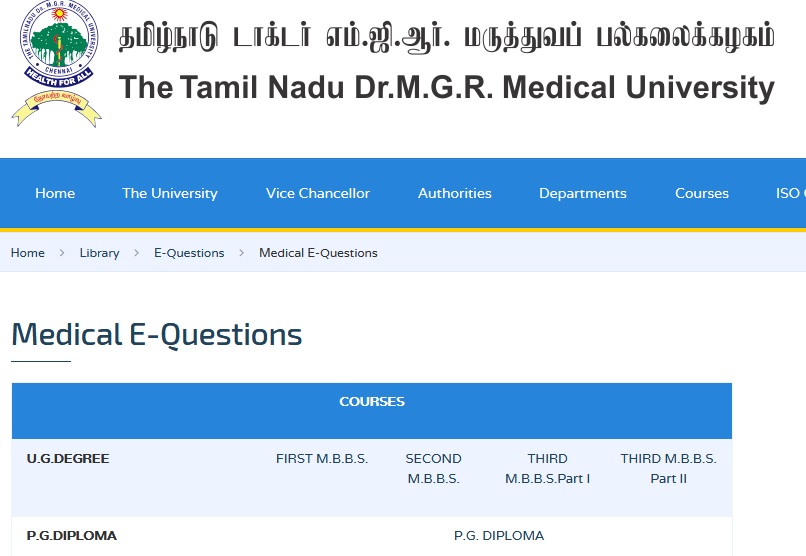Physical & Organic Aspects Of Biochemistry, Instrumentation & Biochemical Techniques & Biostatistics M.Sc Non Medical Question Bank : web.tnmgrmu.ac.in
Name of the University : The Tamilnadu Dr. M.G.R. Medical University
Degree : M.Sc Non Medical Degree Examination
Subject Code/Name : 1201/Physical & Organic Aspects Of Biochemistry, Instrumentation & Biochemical Techniques & Biostatistics
Year : I
Paper : II
Document Type : Question Bank
Website : web.tnmgrmu.ac.in
Download Model/Sample Question Paper :
2012-2013 : https://www.pdfquestion.in/uploads/web.tnmgrmu.ac.in/4062-281201LA.pdf
TNMGRMU Organic Aspects Of Biochemistry Question Paper
Sub. Code: 1201
M.Sc BIOCHEMISTRY DEGREE EXAMINATION
Candidates admitted from 2008-2009 batch
PAPER I : PHYSICAL AND ORGANIC ASPECTS OF BIOCHEMISTRY, INSTRUMENTATION AND BIOCHEMICAL TECHNIQUES & BIOSTATISTICS
Q.P. Code : 281201
Time : Three hours
Maximum :100marks
Related : Recent Advances in Surgical Oncology M.Ch Question Bank : www.pdfquestion.in/4593.html
OCTOBER 2011
Answer All questions.:
I. Elaborate on :
1. What are carbohydrates? How are they classified? Explain different types of isomerism in glucose.
2. What is electrophoresis? Enumerate the types of electrophoresis? How Polyacrylamide gel electrophoresis is performed? How it is used in determining molecular weight?

II. Write notes on :
1. Explain Ion selective electrode, its principle and application with suitable example.
2. Subcellular organelles and their markers.
3. Random error and systemic error.
4. Mention the Different types of RNA & Structure of tRNA.
5. Different classifications of amino acids with colour reaction for aromatic amino acids.
6. Active membrane transport with illustration.
7. What are the different Secondary structures of protein what is the structure of collagen.
8. Homopolysaccharide.
9. Principles and instrumentation of Spectrophotometer.
10.How are amino acids separated by chromatography?
OCTOBER 2012
I. Elaborate on :
1. Define electrophoresis & mention the various types. Describe in detail the principle, instrumentation and applications of agarose gel electrophoresis.
2. Describe in detail the various levels of organization of protein structure, its types and elucidation of structure of the different levels of organization.
II. Write Notes on :
1. What are phospholipids? Classify and describe in detail about physiologically significant phospholipids.
2. What are Histones? Mention the various types and their functions.
3. Describe the synthetic nucleotide analogues with examples and their applications.
4. Define polysaccharides with examples. Detail about the various mucopolysaccharides with a note on mucopolysaccharidosis.
5. Classify the various transport mechanism operating in a eukaryotic cell and describe in detail about macromolecular transport.
6. Describe in detail Donnan Membrane equilibrium and its applications.
7. What are the various types of reagent grade water? Describe about how they are produced and their applications.
8. Name the basic biostatistic tests required for assessment of quality in the clinical laboratory and describe about their applications and calculations.
9. What is the ideal method to quantitatively assess serum zinc level in a patient? Describe in detail the principles, instrumentation and applications of the technique.
10.Describe in detail the structure and function of the mitochondria and a note on its disorders.
APRIL 2013
I. Elaborate on: (2×20=40)
1. What is chromatography ? Mention the various types .Describe in detail about any one with a note on applications of chromatography in clinical medicine?
2. Describe in detail the structure of Haemoglobin. Add a note on how the structure of Haemoglobin aids its function.
II. Write Notes on : (10X6=60)
1. Describe in detail subcellular fractionation and identification of various eukaryotic cell organelles.
2. Mention the various types of RNA and describe in detail the structure of tRNA?
3. Describe in detail the principle, instrumentation and applications of chemiluminescence?
4. Define Reference materials . Classify them and describe their applications in laboratory.
5. Describe in detail the Fluid mosaic model of Biomembranes.
6. Classify Fatty acids. Describe their transport in the blood, their functions with a note on lipid peroxidation.
7. How is Glucose transported across the various cells in the body?
8. Define Beer – Lamberts law and its limitations with a note on its applications in spectrophotometry?
9. Describe in detail the structure and functions of Lysosomes and a note on its disorders.
10. Describe in detail the structure of collagen, its types and functions.